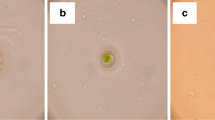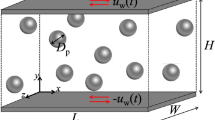Abstract
A systematic study of the rheological properties of solutions of non-motile microalgae (Chlorella vulgaris CCAP 211-19) in a wide range of volume fractions is presented. As the volume fraction is gradually increased, several rheological regimes are observed. At low volume fractions (but yet beyond the Einstein diluted limit), the suspensions display a Newtonian rheological behaviour and the volume fraction dependence of the viscosity can be well described by the Quemada model (Quemada, Eur Phys J Appl Phys 1:119–127, 1997). For intermediate values of the volume fraction, a shear thinning behaviour is observed and the volume fraction dependence of the viscosity can be described by the Simha model (Simha, J Appl Phys 23:1020–1024, 1952). For the largest values of the volume fraction investigated, an apparent yield stress behaviour is observed. Increasing and decreasing stress ramps within this range of volume fractions indicate a thixotropic behaviour as well. The rheological behaviour observed within the high concentration regime bears similarities with the measurements performed by Heymann and Aksel (Phys Rev E 75:021505, 2007) on polymethyl methacrylate suspensions: irreversible flow behaviour (upon increasing/decreasing stresses) and dependence of the flow curve on the characteristic time of forcing (the averaging time per stress values). All these findings indicate a behaviour of the microalgae suspensions similar to that of suspensions of rigid particles. A deeper insight into the physical mechanisms underlying the shear thinning and the apparent yield stress regime is obtained by an in situ analysis of the microscopic flow of the suspension under shear. The shear thinning regime is associated to the formation of cell aggregates (flocs). Based on the Voronoi analysis of the correlation between the cell distribution and cell sizes, we suggest that the repulsive electrostatic interactions are responsible for this microscale organisation. The apparent yield stress regime originates in the formation of large-scale cell aggregates which behave as rigid plugs leading to a maximally random jammed state.













Similar content being viewed by others
Notes
We note that this regime is yet beyond the Einstein’s ultra-dilute limit which was of no particular interest to the present study.
Note that this strongly inhomogeneous flow field significantly departs from the analytical solution of a cone–plate rheometric flow which allows the accurate conversion of the measured torque (T) and angular speeds (\(\Omega \)) into stresses (\(\tau \)) and rates of shear (\(\dot {\gamma }\)).
Note that if one takes into account the measured average cell radius and its standard deviation, one obtains \(t_{\mathrm {br}} \in \left [16.4, 65.7 \right ]\) s (see Fig. 1 and the discussion in Section “Preparation of the Chlorella microalgae suspensions”).
References
Adesanya VO, Vadillo DC, Mackley MR (2012) The rheological characterization of algae suspensions for the production of biofuels. J Rheol 56(4):925–939. doi:10.1122/1.4717494
Basu H, Vecchio A, Flider F, Orthoeter F (2001) Nutritional and potential disease prevention properties of carotenoids. J Am Oil Chem Soc 78:665–675
Becker W (2007) Microalgae in human and animal nutrition. Blackwell, Oxford
Buscall R (2010) Letter to the editor: wall slip in dispersion rheometry. J Rheol 54(6):1177–1183. doi:10.1122/1.3495981
Carvalho AP, Meireles LA, Malcata FX (2006) Microalgal reactors: a review of enclosed system designs and performances. Biotechnol Prog 22(6):1490–1506. doi:10.1021/bp060065r
Cornet JF (2010) Calculation of optimal design and ideal productivities of volumetrically lightened photobioreactors using the constructal approach. Chem Eng Sci 65(2):985–998. doi:10.1016/j.ces.2009.09.052
Cross MM (1965) Rheology of non-Newtonian fluids: a new flow equation for pseudoplacstic systems. J Colloid Sci 20:417–437
de Berg M, Cheong O, van Kreveld M, Overmars M (2008) Computational geometry: algorithms and applications. Springer, Berlin
de Kruif CG, van Iersel EMF, Vrij A, Russel WB (1985) Hard sphere colloidal dispersions: viscosity as a function of shear rate and volume fraction. J Chem Phys 83(9):4717–4725
Dibble CJ, Kogan M, Solomon MJ (2006) Structure and dynamics of colloidal depletion gels: coincidence of transitions and heterogeneity. Phys Rev E 74:041403. doi:10.1103/PhysRevE.74.041403
Doucha J, Straka F, Livansky K (2005) Utilization of flue gas for cultivation of microalgae Chlorella sp.) in an outdoor open thin-layer photobioreactor. J Appl Phycol 17:403–412
Harris E (1989) The Chlamydomonas sourcebook: a comprehensive guide to biology and laboratory use. Academic, San Diego
Herschel WH, Bulkley R (1926) Konsistenzmessungen von gummi-benzollösungen. Kolloid Z 39:291–300
Heymann L, Aksel N (2007) Transition pathways between solid and liquid state in suspensions. Phys Rev E 75:021505
Ikeda A, Berthier L, Sollich P (2012) Unified study of glass and jamming rheology in soft particle systems. Phys Rev Lett 109:018301. doi:10.1103/PhysRevLett.109.018301
Jaishankar A, Sharma V, McKinley GH (2011) Interfacial viscoelasticity, yielding and creep ringing of globular protein-surfactant mixtures. Soft Matter 7:7623–7634. doi:10.1039/C1SM05399J
Kapaun E, Reisser W (1995) A chitin-like glycan in the cell wall of a Chlorella sp. (Chlorococcales, Chlorophyceae). Planta 197:577–582
Krieger IM, Dougherty TJ (1959) A mechanism for non-Newtonian flow in suspensions of rigid spheres. Trans Soc Rheol 3:137
Kumar H, Yadava P, Gaur J (1981) Electrical flocculation of the unicellular green alga Chlorella vulgaris Beijerinck. Aquat Bot 11(0):187–195. doi:10.1016/0304-3770(81)90059-0
Lehr F, Posten C (2009) Closed photo-bioreactors as tools for biofuel production. Curr Opin Biotechnol 20(3):280–285. doi:10.1016/j.copbio.2009.04.004
Liu AJ, Nigel SR (1998) Nonlinear dynamics: jamming is not just cool any more. Nature (London) 396:21
Malkin AY, Masalova I, Slatter P, Wilson K (2004) Effect of droplet size on the rheological properties of highly-concentrated w/o emulsions. Rheol Acta 43:584–591
Mata TM, Martins AA, Caetano NS (2010) Microalgae for biodiesel production and other applications: a review. Renew Sustain Energy Rev 14(1):217–232
Mouget JL, Tremblin G (2002) Suitability of the fluorescence monitoring system (FMS, Hansatech) for measurement of photosynthetic characteristics in algae. Renew Sustain Energy Rev 74:219–231
Mueller S, Llewellin EW, Mader HM (2010) The rheology of suspensions of solid particles. Proc R Soc A 466:1201–1228
Northcote HD, Goulding JK (1958) The chemical composition and structure of the cell wall of Chlorella pyeroidosa. Biochem J 70(3):391–397
Pandey A, Larroche C, Ricke SC, Dussap C (2011) Biofuels: alternative feedstocks and conversion processes, chap 19. Academic, Burlington
Pottier L (2005) Modélisation de photobioréacteurs pour la valorisation des microalgues. PhD thesis, University of Nantes
Putz AMV, Burghelea TI (2009) The solid–fluid transition in a yield stress shear thinning physical gel. Rheol Acta 48(6):673–689
Quemada D (1997) Rheological modelling of complex fluids. I. The concept of effective volume fraction revisited. Eur Phys J Appl Phys 1:119–127
Raffel M, Willert CE, Wereley ST, Kompenhans J (2007) Particle image velocimetry: a practical guide (experimental fluid mechanics), 2nd edn. Springer, New York
Richmond A (2004) Principles for attaining maximal microalgal productivity in photobioreactors: an overview. In: Ang PO, Dumont HJ (eds) Asian pacific phycology in the 21st century: prospects and challenges, developments in hydrobiology, vol 173. Springer, Netherlands, pp 33–37
Satyanarayana KG, Mariano AB, Vargas JVC (2011) A review on microalgae, a versatile source for sustainable energy and materials. Int J Energy Res 35(4):291–311. doi:10.1002/er.1695
Scarano F, Rhiethmuller ML (2000) Advances in iterative multigrid PIV image processing. Exp Fluids 29(1):S051–S060. doi:10.1007/s003480070007
Schmidt M, Münstedt H (2002) Reological behaviour of concentrated monodisperse suspensions as a function of preshear conditions and temperature: an experimental study. Rheol Acta 41:193–204
Shi XM, Chen F, Yuan JP, Chen H (1997) Heterotrophic production of lutein by selected Chlorella strains. J Appl Phycol 9:445–450
Simha R (1952) A treatment of the viscosity of concentrated suspensions. J Appl Phys 23:1020–1024
Spolaore P, Joannis-Cassan C, Duran E, Isambert A (2006) Commercial applications of microalgae. J Biosci Bioeng 101(2):87–96. doi:10.1263/jbb.101.87
Takeda H (1988) Classification of chlorella strains by means of the sugar components of the cell wall. Biochem Syst Ecol 16(4):367–371. doi:10.1016/0305-1978(88)90027-0
Torquato S, Truskett TM, Debenedetti PG (2000) Is random close packing of spheres well defined? Phys Rev Lett 84:2064–2067. doi:10.1103/PhysRevLett.84.2064
Tropea C, Yarin AL, Foss JS (2007) Handbook of experimental fluid dynamics. Springer, Berlin
Ugwu C, Aoyagi H, Uchiyama H (2008) Photobioreactors for mass cultivation of algae. Bioresour Technol 99(10):4021–4028. doi:10.1016/j.biortech.2007.01.046
Wagner NJ, Mewis J (2011) Colloidal suspension rheology. Cambridge University Press, Cambridge
Wileman A, Ozkan A, Berberoglu H (2011) Rheological properties of algae slurries for minimizing harvesting energy requirements in biofuel production. Bioresour Technol 104:432–439. doi:10.1016/j.biortech.2011.11.027
Wu ZY, Shi XM (2008) Rheological properties of Chlorella pyrenoidosa culture grown heterotrophically in a fermentor. J Appl Phycol 20:279–282
Acknowledgments
The project was supported by the Pôle Émergent pour la Recherche Ligèrienne en Énergie (PERLE2) program funded by the Pays de la Loire District, France. We gratefully acknowledge the technical support of Dr. Philippe Sierro and Mr. Etienne Roussel from Thermo Fisher Scientific, Karlsruhe, Germany for the calibration of the nano-torque module installed on the MARS III rheometer and for the optimisation of the RheoScope module. T. B. gratefully acknowledges the enlightening discussions with Miguel Moyers-Gonzalez. A. S. , J. P. and J. L. are grateful to M. Frappart for providing a large quantity of algae suspensions and to D. Grizeau for his precious insights on the algae structure. Last but not least, we are particularly indebted to the anonymous referees for their enlightening comments, remarks and suggestions.
Author information
Authors and Affiliations
Corresponding author
Rights and permissions
About this article
Cite this article
Souliès, A., Pruvost, J., Legrand, J. et al. Rheological properties of suspensions of the green microalga Chlorella vulgaris at various volume fractions. Rheol Acta 52, 589–605 (2013). https://doi.org/10.1007/s00397-013-0700-z
Received:
Revised:
Accepted:
Published:
Issue Date:
DOI: https://doi.org/10.1007/s00397-013-0700-z




